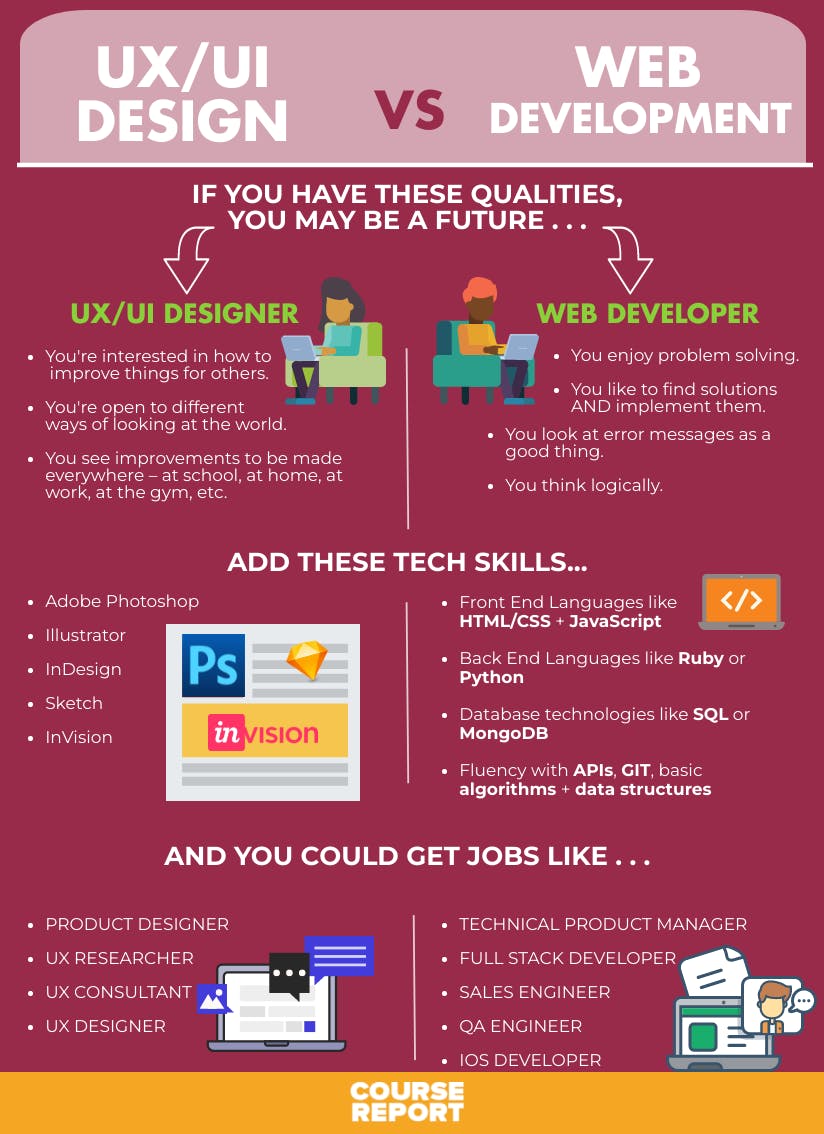Guide
Choosing Between UX/UI Design vs. Web Development
![]()
Written By Lauren Stewart
![]()
Edited By Jess Feldman
![]()
Written By Lauren Stewart
![]()
Edited By Jess Feldman
Course Report strives to create the most trust-worthy content about coding bootcamps. Read more about Course Report’s Editorial Policy and How We Make Money.
Course Report strives to create the most trust-worthy content about coding bootcamps. Read more about Course Report’s Editorial Policy and How We Make Money.
You’ve heard the terms UX/UI Designer and Web Developer, but do you understand the differences between these tech roles? Here's what you should consider when choosing between UX/UI Design vs Web Development, the types of jobs you could land after a bootcamp, and the soft skills you’ll need in each role. Professional UX Designer and Educator Jimmy Chandler gives us the scoop.
| UX/UI Design | Web Development | |
|---|---|---|
| Definition | Focuses on the user's experience and interface design. | Involves writing the code that brings the designs and ideas to life. |
| Main Tasks |
|
|
| Role in Web Building | Determines what the website should do and look like. | Makes the website functional and operational. |
| Tools/Skills |
|
|
| Coding Knowledge | Some knowledge may be beneficial, but not used in the same way developers do. | Essential to the role. |
| Soft Skills | Presenting, listening, receiving critique. | Logical thinking, persistence, attention to detail. |
| Career Path after Bootcamp | Roles may include Product Designer, User Researcher, UX Consultant. For beginners: internships leading to entry-level jobs. | Positions might be Technical Project Managers, Full Stack Developers, Product Managers, among others. |
| Collaboration | Collaborate closely with developers, clients, and stakeholders. Often involved in project requirements and research tasks. | Work closely with designers to ensure the coded website aligns with the design. Participate in collaborative research tasks. |
| Your Background |
|
|
UX stands for user experience and UI stands for user interface.
A designer starts by identifying what problems people have in their lives – at school, at home, at work, at the gym, anywhere. Then designers work out how a website or an app on their computer or their phone could help people solve those problems. Designing is solving problems, it’s not creating art.
A design needs to fit within the capability and brand of the company that needs it. AT&T is not going to build an app to help me figure out what shoe will fit my feet, because that's not what they do. So that's a part of the designer’s responsibility, to ensure that the business goals match the needs of the target customers.
Developers write the code to bring those UX designs and ideas to life. Developers use languages like HTML, JavaScript, Ruby, C++, and many more. They connect the code to real data through databases and APIs, and then they test to make sure their code works properly.
When building a website, the UX/UI designer determines what the team should build and what the website should do; the developers make the website work and make it functional.
How should I choose between a design bootcamp vs. web development bootcamp?
If you’re choosing design:
If you’re choosing web development:
How do designers and developers work together to build a project?
Designers and developers may both be responsible for writing or evolving project requirements, and working with a client or product manager. I find that the best software teams integrate designers and developers to work together. Methodologies known as Agile, Lean or Balanced Teams when implemented well encourage this kind of deep collaboration. It’s not just about having meetings once a week together, but actually working together in the same space. The developer codes the software so that the screen looks the way the designer wants it to look.
But there are a lot of other ways you can collaborate. For example, I've brought developers into our design team’s research tasks in a project. They're not just seeing a report at the end or watching a video, they're actually participating from the start.
Which tools do you need to know in order to be a good designer?
Some of the popular tools that designers use are:
It’s important not to say, “I only work with this one tool." The ability to learn and adapt to new tools is a skill that all designers need to have because you don't know what tools your next job or project will require.
Do designers need to know how to code?
Designers are going to need to be able to use some software. Designers may know how to code as a skill: they may use HTML, CSS, and even JavaScript. But even then, designers don’t use code in the same way that developers do. It's not about coding skills the way it is for developers.
Which soft skills are important for designers?
If you want to be effective as a UX/UI designer, soft skills are just as vital as hard skills. These include presenting, listening, and learning how to give and receive critique. If you can't clearly communicate your ideas and your designs to your client or the decision maker, it doesn't matter how good the design looks. Being open to critique is vital – you’ll have to take feedback and criticism from a lot of different parties without taking it personally.
Are there specific skills that a prospective designer should have?
This is what I look for in UX design students:
You don't have to be artistic – I'm not artistic! Design is about solving problems for real people. It’s a mix of art and science. Being artistic and creating things can be helpful in UX/UI when you're working on the aesthetics of a product, but it's not a prerequisite. I started out writing first, coding second, and only later did I delve into design. I was not trained in visual design. I picked up my visual design skills along the way from great people I worked with.

What types of skills would lend someone to become a web developer versus a designer?
Being a logical thinker, being persistent, and wanting to figure out hard problems. You don't have to be a mathematician, but being able to speak in a logical way is very important.
Developers should be able to see the “big picture” as well as small details. Often times, there are many solutions to a problem, but one will stand out as the best when looking at the full context or business goal.
Do web developers need design skills to be successful?
From the developers' point of view, I think learning design skills are very helpful in your career. Are design skills necessary for a back end developer? Probably not. If you want to be a front end developer, then the more you understand about design, the better you’ll be at your job.
On some teams, one person will cover both roles. For example, a Front End Designer or Front End Developer might conduct user research, create visual designs in tools such as Sketch, Illustrator, or Photoshop, and code it in HTML, CSS, and JavaScript.
What types of roles can UX Design grads expect to get right after bootcamp?
A lot depends on an individual student’s background. If a student was already a successful visual designer, such as graphic design for websites/apps, they may have a better chance over somebody who just graduated college with a degree in English and has never done anything with design or software. If you're already in the design field, our goal is to get you a better job as a Product Designer, User Researcher, UX Consultant, or UX Designer.
If you’re a beginner and really dedicated to being a designer and you put the time and effort into it, you should be qualified to at least get an internship in design, which can lead to an entry-level job opportunity.
What type of roles web development bootcamp grads get?
Web Development Intensive grads have found a wide variety of roles using their new technical skills combined with past experience. Some different positions include Technical Project Managers, Product Managers, Full Stack Developers, Sales Engineers, QA Engineers, iOS Developers, UX Designers, and even entrepreneurs starting their own company.
What’s it like being a UX designer in the field?
I continue to learn about users’ commonalities and differences and the role of technology in their lives in practically every project that I work on. That has such a profound impact on how I actually design and research.
I’ve found the best way to build products is collaboratively. In the “old way” of building software, a client gave us requirements and then we designed, received feedback, and handed it off to somebody else. In a collaborative situation, instead of just getting a client’s requirements and working by myself, I work with the client as my expert. Clients are the experts in what their needs and problems are; I’m the expert in design. Agile and Lean methodology allows you to include stakeholders, decision-makers, and users in the product so that you build it better and more cost-effectively.
How can people prepare for design and web development bootcamps?
If you're interested in design or web development, here are some great UX design resources:
Here are some web development resources:

Lauren Stewart, Content Management, Diversity & Equity
Lauren is a communications and operations strategist who loves to help others find their idea of success. She is passionate about techonology education, career development, startups, and the arts.

Jess Feldman, Content Manager at Course Report
Jess Feldman is an accomplished writer and the Content Manager at Course Report, the leading platform for career changers who are exploring coding bootcamps. With a background in writing, teaching, and social media management, Jess plays a pivotal role in helping Course Report readers make informed decisions about their educational journey.










Sign up for our newsletter and receive our free guide to paying for a bootcamp.
Just tell us who you are and what you’re searching for, we’ll handle the rest.
Match Me